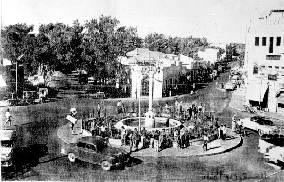
Since the prisoners began their hunger strike, the centre of Ramallah, to appropriate an oft-used local phrase, has "caught fire". It started in the usual place, the myriad of traffic islands that litter the town centre, a busy node where six roads converge called the Manara. A tower once rose from the roundabout's sculptured gardens (pictured left in the 1960s) until bulldozed by the Israelis in the 1980s to make way for military vehicles. Now thick smoke rises from the Manara, a cry of the times from the traffic islands stained with the blackened rubber and steel radials left by yesterday's burnt tyres.
My house is about 200 yards away down the Bir Zeit road, forcing me to have to pass through the Manara if I want to shop or catch a taxi to Bir Zeit University where I work. Unlike the occasional clash over the past nine months I have been here - the type that you only realise happened when you see debris from tyres, stones and bottles later on in the day - the recent protests are continuing daily and increasing in intensity. Three mornings ago. I woke up to Israeli soldiers firing machine guns outside my front gate. My flatmate and a visitor were sitting outside and went off to the Manara to see what was happening.
I rolled over and tried to go back to sleep. The previous day, before the escalation. I had been in the Manara when local youths set tyres ablaze and tossed stones up and down in bored hands while waiting for the army to arrive. They disappeared, in accordance with the usual ritual, when the jeeps rolled up, to hide in the maze of streets to wait for an appropriate opportunity. The soldiers descended from their jeeps and asserted themselves in the Mcrnara with some suitable cinematic strutting and waited for the first missile. They too were bored but had hopes for at least some relief from the tedious task of their daily, unpopular patrols, notable for their failure to impress anyone and unfathomable in that no one needs this protection in what is an exclusively Arab town with no settler population.
Relief for all came in the form of two flying bottles, falling with tinkling, musical crunches pitifully far short of their target. If the youths filled them with water first, they might go further and hit harder but of course there has been no water in much of the centre of town for some weeks. Two soldiers lope off after the throwers and reappear five minutes later, dragging two teenagers to a jeep.

Having watched similar exchanges countless times before, an observer is driven to conclude that there is a script being followed, that the purpose being achieved is one that exists only in the subconscious -- a primal release from the monotony of a town with no regular cinema, four restaurants and a million monochrome burger bars. Everyone seems to be performing and it is all somehow not quite real; the costumes and sets are fantastic, but it is unarguably B-movie acting.
The two teenagers look like Arab-Americans judging by the baseball caps (everyone wears a costume here), who perhaps arrived in Ramallah a month ago. Today they are playing Intifada. As they are being put into the jeep, a woman in an Islamic headscarf walks past me with her two children. A few seconds later, a female American voice says: "Look kids, you saw it on the TV, now you are seeing it again in reality." I turn round to see the same womcrn and kids. She probably never wore a hijab in her life before she came here. I restrain myself from ruining her day by pointing out that both this and TV lack some basic elements of reality. After a while , everyone goes home, to return an hour later, of course, for a rerun.
More than anything, it is my annoyance at the game that somehow got me out of bed and into the shower the morning the gunfire beat my alarm clock to it. As I sat down to breakfast, my flatmate arrived back. It is clear from his story that there is a different quality to the events today, soldiers beating old women's head against walls for one thing. Somehow, there has been a subtle transformation from play to war. In the few days since then, the horror stories have continued to come in, as friends stop by our house, in its central location, within earshot of the sporadic sound grenades and rubber bullet canisters going off. Another old woman was caught either throwing rocks or breaking them for the youths to throw, so the soldiers put her on the ground and smashed one of her legs until her bone gave way. A boy in his early teens was beaten savagely to the ground with batons wielded by several soldiers. Another boy, arrested and thrown in a jeep, was kicked in the head repeatedly by two other soldiers.
Since the 'fire' caught, dozens of people have been arrested. Most will be taken to the tents in Ramallah prison, beaten up a little more and then released. Foot patrols of soldiers stalk the streets. In some areas of Ramallah, there have been what amounts to running battles carrying on late into the night between local youths and the army. So far, live ammunition has only been shot into the air. Today the imam in the nearest mosque is screaming himself to an early coronary. Ramallah's shop-keepers have declared an open-ended strike starting next week and Hamas have distributed leaflets calling for another Intifada.
So, this is reality? I'm beginning to wonder if I don't prefer the movies.
This article originally appeared in Middle East International magazine, issue 505, 21 July 1995.
Related sites
- Photo above taken from American Federation of Ramallah Palstine (AFRP) website. Visit AFRP's website, which includes a photo gallery of the town.